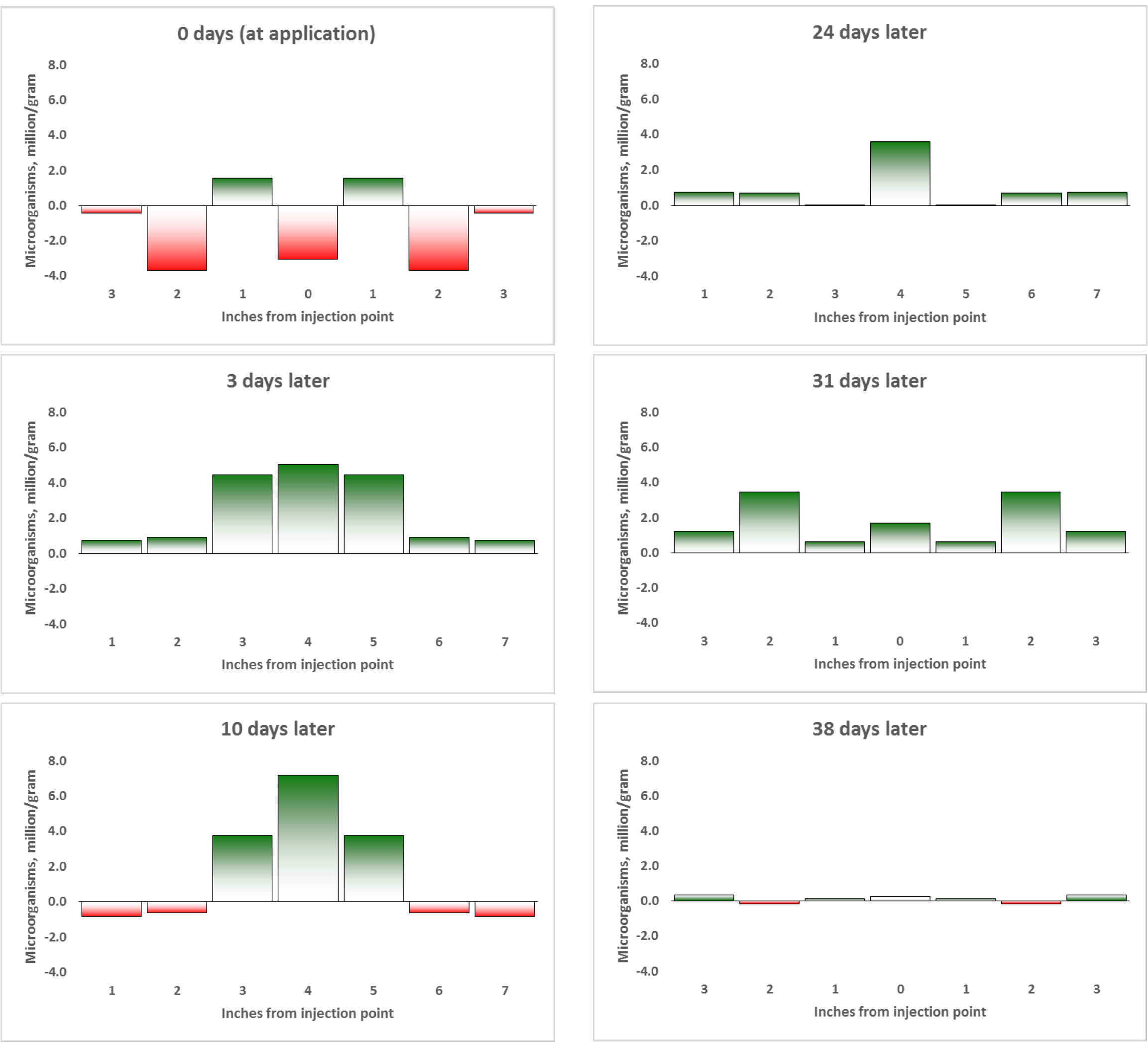⇦ Back to Fertilizer Lime Amendment Technology and Use Home
¶ Introduction
Use of anhydrous ammonia is claimed by some of causing damage to the soil. Among other things, anhydrous ammonia is blamed for killing off soil organisms, like bacteria and earthworms. These organisms perform many vital functions, like forming soil humus and converting crop residue to plant available nutrients.
Research shows that although anhydrous ammonia kills organisms close to the soil injection point, it has no appreciable effect on microorganism populations. Only a small number of organisms are affected and the affected microbial populations rebound quickly in the affected soil zones
¶ Soil Volume Affected
One reason that anhydrous ammonia has little overall impact on soil organisms is that only a small amount of the total soil volume is affected. Anhydrous ammonia does not affect the entire soil volume, but spreads radially from the injection point to form a cylindrical zone along the row. The ammonia concentration would be greatest at the injection point, decreasing with distance away from the point.
For example, if ammonia is applied at 200 pounds of nitrogen per acre on 30-inch spacing, the ammonia retention zone typically ranges from about 3 to 6 inches in diameter, depending on soil conditions. The retention zone diameter is larger in very dry and/or sandy soils. The zone diameter is smaller with lower rates and narrower application spacing.
Assuming a 4-inch retention zone, an application would enrich a soil volume of 1,520 cubic feet per acre with ammonia. An acre of soil, 8 inches deep, has a total volume of 29,040 cubic feet. The cylindrical retention zone would occupy only 5.2% of the total volume of this surface soil.
The mass of microorganisms and earthworms in a surface soil can range from just under one ton to over five tons per acre (see Table 1). A 5% (or even 10%) reduction in organism numbers would mean that there would still be over 1,000 to nearly 10,000 pounds of organisms remaining in the soil.
An average 5% reduction can mean relatively little when the sheer numbers of organisms are considered. Table 2 shows that a population of over 11 billion individual organisms per gram is typical. Eliminating 10% of the organisms would still leave nearly 10 billion microorganisms per gram to carry on soil processes.
¶ Rapid Recovery
Research shows that soil microorganism populations recover rapidly after anhydrous ammonia is applied. These experiments were carried out in 1954, before anhydrous ammonia and other farm chemicals were widely used. The nitrogen rate in this field study was 100 lb. N on 16-inch spacing (equivalent to 190 lb. of N with 30-inch spacing). Fertilizer was applied to a loamy fine sand with a soil pH of 5.6.
¶ Table 1. Approximate Weight of Organisms in the Surface Six Inches (Pounds Per Acre). |
|
| Bacteria | 400 – 4,000 |
| Actinomycetes | 400 – 4,000 |
| Fungi | 500 – 5,000 |
| Algae | 50 – 500 |
| Protozoa | 15 – 150 |
| Nematodes | 10 – 100 |
| Earthworms | 100 – 1,000 |
| Other | 15 – 150 |
| TOTAL, lb/ac-6 in | 1,490 – 10,900 |
¶ Table 2. Estimated Number of Microorganisms per Gram of Soil* |
|
| Bacteria | 10,000,000,000 |
| Actinomycetes | 1,000,000,000 |
| Fungi | 10,000,000 |
| Algae | 1,000,000 |
| Protozoa | 1,000,000 |
| Nematodes | 1,000 |
| TOTAL, lb/ac-6 in | 11,012,001,000 |
| *One gram = 0.03527 ounces. A dime weighs 2.2 grams.) | |
Figures 1 through 6 show the changes in microorganism populations (bacteria, fungi, and actinomycetes) over time at different distances from the point of ammonia injection by comparing populations in ammonia treated plots to those in non-treated plots. The researchers found that microorganisms farther than 4 inches away from the injection point were not affected by the ammonia application.
The high concentration of ammonia in the retention zone was toxic to bacteria and fungi immediately after application (0 days). The injection point pH ranged from 7.8 to 8.4. By the tenth day, the ammonia treated soil had several times more bacteria than the check soil.
Both pH and ammonia concentration decreased as the ammonium converted to nitrate (nitrification process). The bacteria and fungi numbers increased over time, until by five to seven weeks after application, they were comparable to the numbers found in the untreated soil.
The researchers conducted this experiment in several different ways and came to the same conclusion: there is no long-term detrimental effect on soil microorganisms due to applying anhydrous ammonia.
¶ Figure 1. Net effect* of anhydrous ammonia on the numbers of fungi, bacteria, and actinomycetes in loamy fine sand**, millions of organisms per gram of soil.

*Net effect equals numbers in ammonia-treated soil minus numbers in untreated soil.
**100 Ib NH3-N/ac, 16-inch spacing; Arredondo loamy fine sand, CEC = 4.8 meq/100 g, pH = 5.6
¶ References:
Brady, N.C. 1974. The nature and properties of soils. Macmillan Pub. Co., New York. pg. 114.
Eno, C.F. and W.G. Blue. 1954. The effect of anhydrous ammonia on nitrification and the microbiological population in sandy soils. Soil Sci. Soc. Proc. 18:178181.